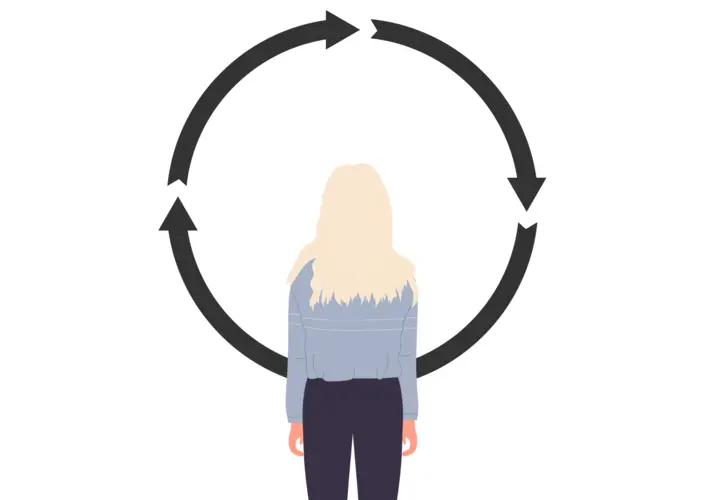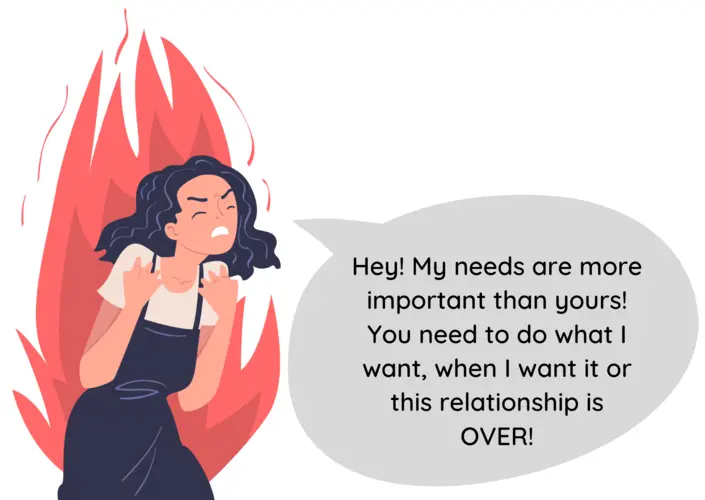A common challenge that blocks the path to recovery for many people trying to heal from narcissistic abuse is a trauma bond.
We had the pleasure of interviewing Dr. Sara Spowart about trauma bonding, and she outlined the following 11 steps for breaking a trauma bond:
- Increase Your Awareness of Your Situation
- Use Radical Acceptance to Maintain Awareness of Your Situation
- Identify Your Core Wounds and Vulnerabilities
- Work on Healing Your Core Wounds and Vulnerabilities
- Identify Areas for Improvement in Your Life Separate from the Narcissist
- Identify Manageable Steps You Can Take To Improve Your Life
- Implement the Identified Steps into Your Life
- Identify the Hooks the Narcissist Uses to Pull You Back In
- Commit to Being Aware of These Hooks and Track How the Narcissist Uses Them
- Add More Positive Things to Your Life
- Go No or Low Contact with the Narcissist
In this article, I will explain each of these steps and provide you with resources you can use to complete them.
Step 1: Increase Your Awareness of Your Situation
During our interview, Dr. Sara Spowart outlined that the first step to breaking a trauma bond with a narcissist is increasing your awareness of your situation.
Suggested Reading: How to Know if a Bond Is Trauma or Love
What does this mean?
During the interview, Dr. Sara Spowart said, “To stop being in the cycle, you need to see the cycle, which means taking a step back.”

She was referring to the cycle of emotional abuse that narcissists typically use to strengthen the trauma bond with the person they are abusing.
Her point was that if you don’t take the time to increase your awareness of your situation, you’ll likely end up trapped in the cycle of abuse without even realizing it.
So the first step to breaking free from the trauma bond is increasing your awareness so you can understand that the issue is real and not your fault.
Step 2: Use Radical Acceptance to Maintain Awareness of Your Situation
The second step that Dr. Sara Spowart outlined was using radical acceptance to maintain awareness of your situation.
This is important because the first step that Dr. Sara Spowart outlined essentially asks you to acknowledge and accept that someone you care about is causing you harm.
This can be an excruciating thing to do, and you may accidentally try to protect yourself from this pain by searching for ways to justify the narcissist’s actions.

Using radical acceptance to maintain awareness of your situation is about fully acknowledging it without trying to justify it.
You accept that the narcissist is who they are, recognize that their behavior is harmful, and understand that the issue is real and it’s not your fault.
Step 3: Identify Your Core Wounds and Vulnerabilities
The third step outlined during our interview with Dr. Sara Spowart was identifying your core wounds and vulnerabilities.
You see, there is likely a wound or vulnerability that the narcissist in your life has capitalized on to manipulate you into a trauma-bonded dynamic.
Identifying these core wounds and vulnerabilities is key to understanding why the trauma bond with the narcissist has formed in the first place.
Once you clearly understand your core wounds and vulnerabilities, you can set healthy boundaries that give you the time and space to work on healing them.
Healing your core wounds and vulnerabilities will help you develop the skills to protect yourself from emotional abuse and break free from the trauma bond.
Step 4: Work on Healing Your Core Wounds and Vulnerabilities
Dr. Sara Spowart’s fourth step was to work on healing your core wounds and vulnerabilities.
In the previous section, we touched on the fact that healing your core wounds and vulnerabilities will help you develop the skills needed to break a trauma bond.
But there is another reason that healing your core wounds and vulnerabilities is so important.
You see, healing from narcissistic abuse is not just about breaking the trauma bond but also about growing as a person.
Suggested Reading: 10 Ways to Grow as a Person After Narcissistic Abuse
When you focus on healing your core wounds and vulnerabilities, you do a tremendous amount of self-reflective work.
Over time, this will help you rebuild your identity and sense of self-worth, regain your autonomy, and subsequently grow as a person.
This, in turn, will make you less susceptible to the narcissist’s manipulations, help you break free from the trauma bond, and allow you to cultivate a fulfilling life.
Step 5: Identify Areas That You Can Improve in Your Life Separate from the Narcissist
The fifth step Dr. Sara Spowart outlined during our interview was identifying areas you can improve in your life, separate from the narcissist.
This is significant because narcissists often force the people that they abuse to prioritize the narcissist’s well-being over their own.

Over time, this can make the abused person feel like their entire life revolves around the narcissist, making breaking the trauma bond feel impossible.
By identifying areas for improvement unrelated to the narcissist, you are shifting your focus away from them and permitting yourself to prioritize your well-being.
This is an important fifth step to breaking free from a trauma bond because it puts you in a position to start building a life separate from the narcissist.
Step 6: Identify Manageable Steps to Improve Your Life
After you’ve identified the areas that you can improve in your life, separate from the narcissist, the sixth step that Dr. Sara Spowart outlined during our interview was to identify manageable steps to improve those areas in life.
This is great advice because a lot goes into identifying areas in your life that you can improve and doing the work to improve them.
If you try to rush this process, you’ll most likely end up feeling overwhelmed and demoralized.

However, if you identify manageable steps to improve these areas in your life, these steps will accumulate into a significant shift in your lifestyle and mindset, strengthening your ability to break the trauma bond.
Step 7: Implement the Identified Steps into Your Life
The seventh step Dr. Sara Spowart outlined during our interview was implementing the manageable steps you identified during the sixth step into your life.
You see, it’s not enough to identify the steps you need to take. You must also put them into practice.
Now, implementing these steps is much easier said than done, especially if the narcissist in your life tries to sabotage your efforts.
But each step you take, however small, is a small victory and creates a stack of undeniable proof that you can break the trauma bond, heal, and cultivate a fulfilling life that reflects your authentic self.
By taking action, you assert your autonomy and make real changes in your life that further solidify your identity separate from the narcissist.
Step 8: Identify the Hooks That the Narcissist Uses to Pull You In
The eighth step Dr. Sara Spowart outlined in our interview was identifying the hooks the narcissist uses to pull you in.
Unfortunately, narcissists use a variety of tactics, or ‘hooks,’ to reel the person they are abusing back in.
Suggested Reading: How Do Narcissists Try to Win You Back?
By identifying these hooks, you can see the pattern, understand the narcissist’s manipulative tactics, and protect yourself from emotional abuse.
It’s a form of empowerment that allows you to take control of your interactions and aids in breaking the trauma bond.
Step 9: Commit Being Aware of These Hooks and Track the Narcissist’s Usage of Them
The ninth step Dr. Sara Spowart outlined during our interview was committing to being aware of these hooks and tracking the narcissist’s usage of them.
She said this because maintaining consistent awareness of the narcissist’s hooks is just as important as identifying them.

Narcissists can be unpredictable and may switch tactics, so you must ensure you are always vigilant.
This doesn’t mean ruminating about the hooks. It means being aware of the narcissist’s behaviors and strategies so you aren’t caught off guard.
Doing this puts you in a position where you can protect the progress you make on your journey toward breaking free from the trauma bond.
Step 10: Add More Positive Things to Your Life
The tenth step Dr. Sara Spowart outlined during our interview was adding more positive things to your life, which is an important part of healing.
Suggested Reading: 10 Simple Steps for Finding Happiness After Narcissistic Abuse
This can come in various forms, such as engaging in activities you enjoy, spending time with supportive friends, or learning something new.
Adding positivity to your life not only helps you find joy and fulfillment outside of the relationship that you had, or currently have, with the narcissist, but it also boosts your self-esteem and sense of self-worth.
This growing confidence and happiness in yourself can help you protect yourself from the narcissist’s tactics and strengthen your ability to break the trauma bond.
Step 11: Go No or Low Contact with the Narcissist In Your Life
Dr. Sara Spowart outlined the eleventh step during our interview: go no or low contact with the narcissist in your life.
If possible, going no contact is the most effective way to break the trauma bond. This means cutting off all forms of communication and connection with the narcissist.
However, if no contact isn’t feasible, setting strict boundaries for minimal contact is important.
Suggested Reading: Why Is It So Hard to Go No Contact With a Narcissist?
The most common way this is achieved is through the Low Contact Method.
This means only interacting with the narcissist in your life when necessary, refusing to engage in arguments, and not responding to their attempts to manipulate you.
By going low contact, you protect your emotional space and prevent the narcissist from further exploiting your vulnerabilities, helping break the trauma bond.
What Should You Take Away from This Article?
I hope you found the 11 steps Dr. Sara Spowart outlined during our interview helpful.
Thank you so much for reading this article.
I enjoy creating this content for you, so you reading it means a lot.
If you’re ready to heal, visit The Institute of Healing from Narcissistic Abuse to get started.
About the Author

Hey, I’m Elijah.
I experienced narcissistic abuse for three years.
I create these articles to help you understand and validate your experiences.
Thank you for reading, and remember, healing is possible even when it feels impossible.
